
‘Recipe for Hope’, banner drawing together the instructions from the school children addressing their active hope for our planets future.
Earlier this year, I was asked to work with the Great North Museum on a very large project working with ten schools across the North of England to design and paint eleven two metre sized banners which illustrated the young peoples deep concern for our planet and what we are doing to it. These banners are instructions for us to follow. The banners were to be a ‘Recipe for Hope’ for the future and to be hung in the museum whilst ‘Dippy’ the diplodocus skeleton was on display there as part of #dippyontour from the Natural History Museum .

Warkworth C of E Aided Primary School – ‘Respect our seas’.
The ‘Eco Club’ at Warkworth School, made up of children from Year 1-6, have worked very hard within their local community to challenge people to think about their use of plastic and the importance of recycling. The ‘Eco Club’ are worried about the effect irresponsible disposal of rubbish and an over-reliance on plastic is having on not just land animals but also creatures which live in the sea. Their banner illustrates ‘Life Below Sea’ and how the sea should be free from: pollution from rubbish and chemicals; over fishing which can affect biodiversity and the food chain; and the acidification of the water currently taking place.
The Warkworth School ‘Eco Club’ calls for us to “Look after the ocean”, “Respect our seas” and “Save our wonderful creatures”.
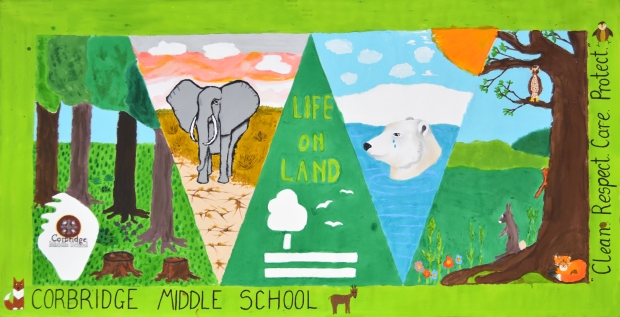
Corbridge Middle School – ‘Clean, Respect, Care, Protect.’
Pupils from Corbridge Middle School are angry as “Humans have already reduced the number of animals on our planet by 60%”. They and future generations will suffer the consequences of this, along with other climate and environmental disasters if we don’t make big changes now. The pupils aged between 9 and 13 years wanted to use their banner design to raise issues which are part of the United Nations Sustainable Development Goal 15 ‘Life On Land’. The goal includes: reforestation; halting the loss of biodiversity; preventing extinction and ending animal trafficking. To reverse these trends, we need to be living more sustainable lifestyles and reversing land degradation.
The pupils had a simple message: “Clean. Respect. Care. Protect” – “YOU can save the World.”
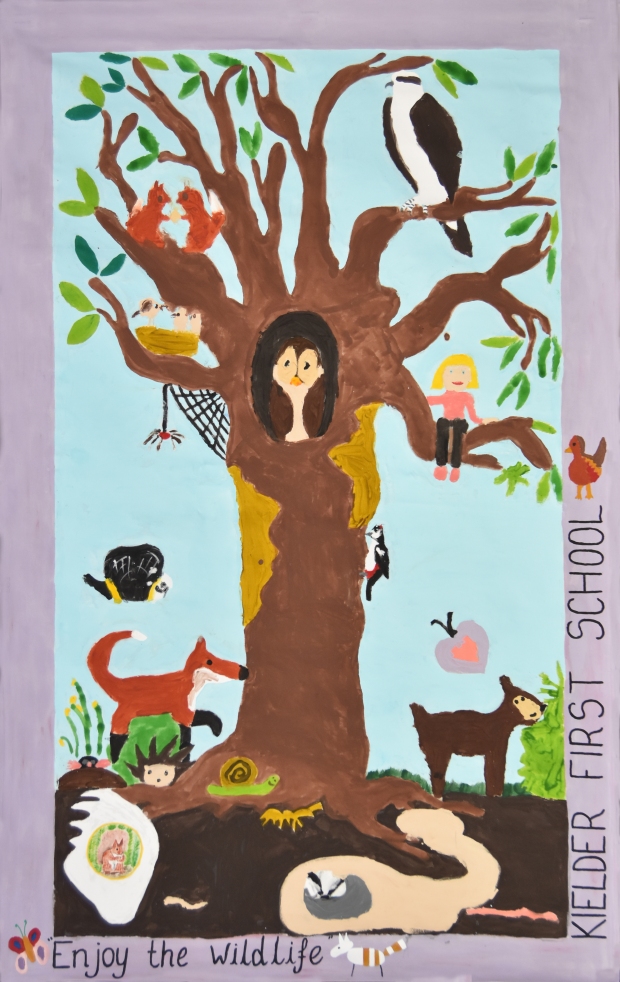
Kieder First School – ‘Enjoy the wildlife’
The children who attend Kielder First School live in an area of special scientific interest, home to over 50% of England’s Red Squirrel population., with Osprey and Roe Deer nearby. Besides conifers, Kielder Forest also has cherry, oak, beech, willow and birch trees. This woodland provides habitats for bugs in the ground layer; grasses, ferns, flowering plants and deer; through to smaller trees and shrubs; and birds and squirrel up in the canopy. This densely populated, biodiverse habitat can still be affected by weather changes, seasonal variance affecting food supply and even fly tipping! The young children were very aware of how easily their beautiful surroundings and the creatures that live there can be adversely affected by laziness and lack of respect for their beautiful countryside.
The children from Kielder First School were keen for everyone to remember to visit and “Enjoy the wildlife” but to “Put your rubbish in the bin” and “Look after the trees”, as they look after us and make a home for the wildlife.
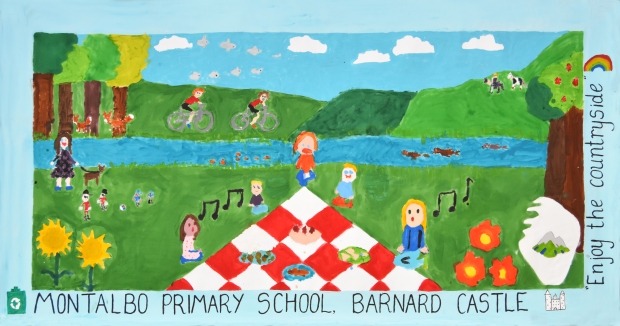
Montalbo Primary School – ‘Enjoy the countryside’
Montalbo Primary School is close to the countryside with woodland, rivers, upland and moorland habitats. This brings rich diversity and natural beauty. But the children at the school realise that to maintain it, it needs to be protected and used. They are setting up an ‘Eco Club’ and working towards their ‘Green Flag Award’.
The design of their banner shows some of the many ways everyone can “Enjoy the countryside” as “Exercise makes you happy”. By looking after our natural habitats such as rivers, woodland and hills for walking, we can encourage tourism which will bring money to the area not just from visitors but it will also provide incentives for governments and individuals to keep these areas intact. The children regularly play football, ride horses, take picnics and visit the river; besides their physical health it also maintains their mental wellbeing.
The children from Year 3 at Montalbo Primary School want to remind us all to “Look after our World”, “Visit the countryside” and “Enjoy the fresh air.”

South Wellfield First School – ‘A small change can make a big difference.’
The children from South Wellfield First School live close to the coast and visit it regularly with their families and friends. A beautiful coastline encourages people to visit these areas, to spend time and money which helps the local economy. However, the children are keen to point out that to make this a fun and happy place to visit, our beaches need to be free from rubbish and our water clean from pollution. The design for their banner illustrates how they would like to see their local beaches and the sea to be: colourful, clean happy, healthy places for people and wildlife. The children point out that wildlife often mistakes plastic for food and each year millions of animals and birds die because of this. This should not be something that continues to happen in their, and their children’s, future.
The children from Year 4 of South Wellfield First School would like to point out that “A small change can make a big difference” so that all our lives can “Be greener and cleaner”.

St. Bede’s RC Primary School – ‘Less cars, more legs.’
Year 4 at St Bede’s have been learning about science and climate change by being involved in the Polar Explorer Programme and looking at the British Arctic Survey. Although their school has a concrete playground with no green spaces, they have been learning about how they can care and protect for their environment. Living in an urban area the children were very aware of the importance of small but very important things we can all do to help make our local environment a better, cleaner place for the benefit of everyone.
The design for St Bede’s banner draws upon the streets where they live and how they would like them to be: free from litter, with less pollution from traffic and more greenery.
They want to see “Litter free, happy streets.”
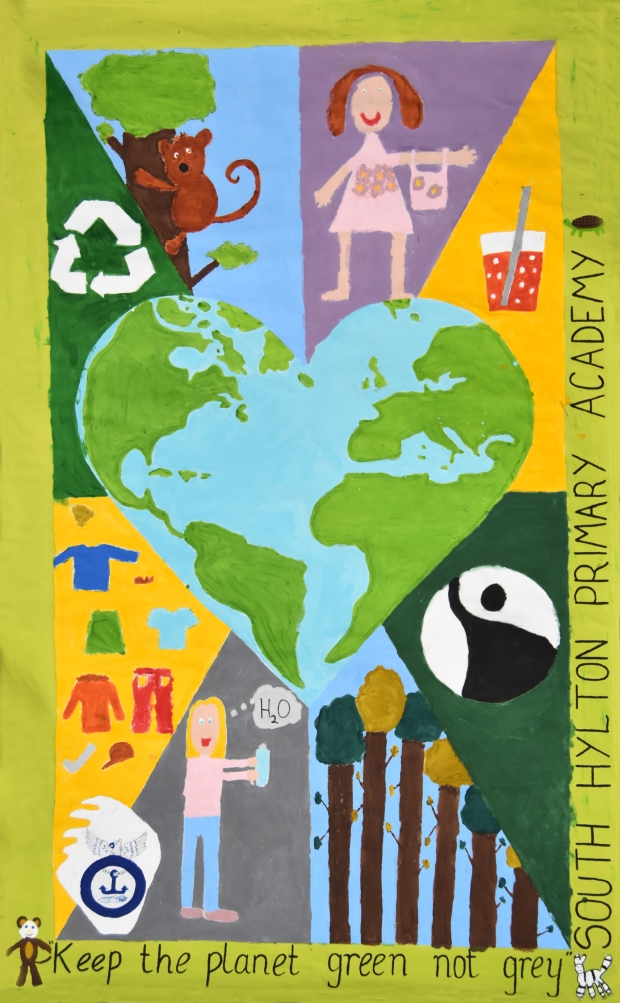
South Hylton Primary Academy – ‘Keep the planet green, not grey.’
Year 3 at South Hylton Primary School are very keen to share some of the very easy ways we can all “Care for the Earth” with their local community and all the visitors to the Great North Museum. The design for their banner reflects some of the things they have been thinking and talking about in school .
Some of the things Year 3 would like us all to try:
• Use a reusable water bottle.
• Always recycle.
• Buy Fairtrade.
• Take clothes to, and buy from, charity shops.
• Don’t use plastic straws.
• Don’t buy things with Palm Oil in.
• Use reusable bags.
• Reduce your food waste.
For the children’s future they say: “Keep the planet green not grey”.
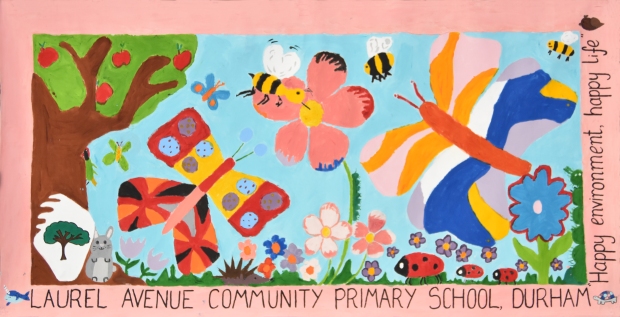
Laurel Avenue Community Primary School – ‘Happy environment, happy life.’
The residential streets around Laurel Avenue Primary School are all named after trees, which you can see to the rear of the school. The children are aware that although they live near Durham City centre, they can play an important part in helping with the habitats of the insects and birds that make urban areas their home. The children feel that having a space for the natural world all around us, no matter where we live, helps us all to feel happier and safer. The Year 5 and 6 children created a design for their banner which reflects the bright happy colours that nature brings us through butterflies, bees, ladybirds, the flowers they pollinate and which might even grow into fruit on the trees. The children had discovered that 9 out of 10 land plants rely on pollination from insects and that it is important to grow pollinator friendly plants and leave wilder patches for insects to hibernate and breed.
One of their motoes is “Happy Environment, Happy Life”.
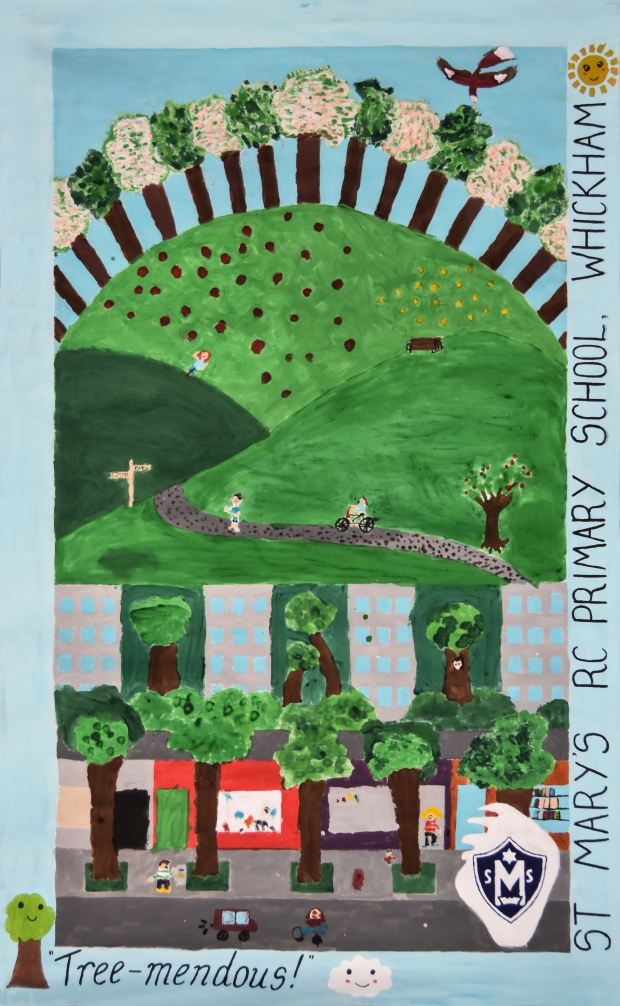
St Mary’s RC Primary School – ‘Tree-mendous!’
The children at St Mary’s Primary School live near to the busy A1 and the Metro Centre. This has encouraged them to embrace the benefits of trees and the natural environment which lies behind their school. They have become very aware of the negative side of being close to busy roads, with all the fumes and what that means for everyone’s health. The children have done lots of research over the last year about the benefits of trees and this has played a big part in their design for their banner.
They point out that:
• Neighbourhoods with few or no trees are more likely to have higher incidents of violence.
• Trees on shopping streets encourage people to slow down, allowing drivers to look at the shop fronts.
• Trees increase property values.
• Trees can be teachers and playmates.
• Trees absorb CO2, removing and storing carbon while releasing oxygen back into the air.
The children of St Mary’s say “Thumbs up for clean air” – “We love trees!”

Lowick and Holy Island C of E First Schools – ‘Keep colour in the world.’
The children of Lowick and Holy Island First School’s design for their banner focuses on how close they live to the sea. They understand the importance of keeping the beach and the unique area they live in clean from rubbish which might wash into the sea; to help with this they carry out a weekly beach clean. Their banner illustrates the two sites of their schools: coastal and lowland. The children feel that the natural beauty that surrounds them should not be taken for granted. Living where they do, concerns about the impact of sea level rises on this beautiful Northumberland coastline are an important consideration.
They wished to pass on the message that we should always remember to “Take our rubbish home” so that we can “Keep other animals safe” and “Keep colour in our World.”
The above photos show the projections within the #dippyontour exhibition using quotes from the pupils who worked on the ‘Recipe for hope’ banners.
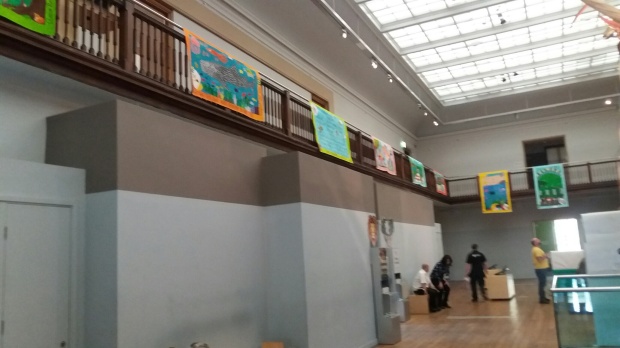
Showing some of the ‘Recipe for hope’ banners on display at the Great North Museum.
Dippy and the school ‘Recipe for hope’ banners will be on display at the Great North Museum until the 6th October, 2019. And if you would like to ‘have a go’ at designing your own family banner, here is a copy of the worksheet designed by the GNM for schools: Design an Eco Banner


